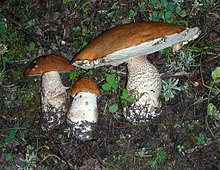| Leccinum insigne | |
|---|---|

| |
| Scientific classification | |
| Domain: | Eukaryota |
| Kingdom: | Fungi |
| Division: | Basidiomycota |
| Class: | Agaricomycetes |
| Order: | Boletales |
| Family: | Boletaceae |
| Genus: | Leccinum |
| Species: | L. insigne |
| Binomial name | |
| Leccinum insigne A.H.Sm., Thiers & Watling (1966) | |
| Synonyms | |
| |
Leccinum insigne, commonly known as the aspen bolete or the aspen scaber stalk, is a species of bolete fungus in the family Boletaceae. Described as new to science in 1966, it is found in North America, where its range extends from eastern Canada south to New Jersey and west to the northern Rocky Mountains. It is a good edible mushroom, but there have been documented cases of adverse reactions; these range from headaches to gastrointestinal distress, which may or may not be attributed to food sensitivities alone. The specific epithet insigne means "distinctive or outstanding".
The cap is orange-brown and semi-fibrillose. The tubes are white to yellowish, staining brownish. The stipe is white with dark scabers. The flesh is white, sometimes turning gray, and possibly bluish in the base.
See also
Species of fungus| Leccinum insigne | |
|---|---|
| Pores on hymenium | |
| Cap is convex | |
| Stipe is bare | |
| Spore print is brown to yellow-brown | |
| Ecology is mycorrhizal | |
| Edibility is edible | |
References
- Šutara J. (1982). "Nomenclatural problems concerning the generic name Krombholziella R. Maire". Česká Mykologie. 36 (2): 77–84.
- "GSD Species Synonymy: Leccinum insigne A.H. Sm". Species Fungorum. CAB International. Retrieved 2014-11-01.
- Phillips, Roger (2010). Mushrooms and Other Fungi of North America. Buffalo, NY: Firefly Books. p. 276. ISBN 978-1-55407-651-2.
- Bessette AR, Bessette A, Roody WC (2000). North American Boletes: A Color Guide to the Fleshy Pored Mushrooms. Syracuse, New York: Syracuse University Press. p. 205. ISBN 978-0-8156-0588-1.
- Beug, Michael W. (July–August 2017). "Amatoxin Mushroom Poisoning In North America 2015-2016" (PDF). The Mycophile. 54 (4): 13. Retrieved 2017-08-21.
- Beug, Michael W.; Shaw, Marilyn; Cochran, Kenneth W. (Fall 2006). "Thirty-Plus Years of Mushroom Poisoning: Summary of the Approximately 2,000 Reports in the NAMA Case Registry" (PDF). McIlvainea. 16 (2). North American Mycological Society: 47–68. Retrieved 2017-08-21.
- Beug, Michael W. "NAMA Toxicology Committee Report for 2007: Recent Mushroom Poisonings in North America" (PDF). Retrieved 2017-08-21.
- Smith AH, Weber NS (1980). The Mushroom Hunter's Field Guide. Ann Arbor, Michigan: University of Michigan Press. p. 103. ISBN 978-0-472-85610-7.
- Trudell, Steve; Ammirati, Joe (2009). Mushrooms of the Pacific Northwest. Timber Press Field Guides. Portland, OR: Timber Press. p. 227. ISBN 978-0-88192-935-5.
| Taxon identifiers | |
|---|---|
| Leccinum insigne | |
This Boletales-related article is a stub. You can help Misplaced Pages by expanding it. |